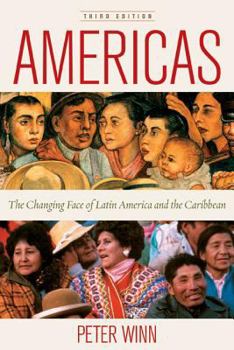Americas: The Changing Face of Latin America and the Caribbean
Select Format
Select Condition 
Book Overview
Stunning in its sweep, Americas is the most authoritative history available of contemporary Latin America and the Caribbean. From Mexico to Tierra del Fuego, and from Cuba to Trinidad and Tobago, Americas examines the historical, demographic, political, social, cultural, religious, and economic trends in the region. For this new edition Peter Winn has provided a new preface and made revisions throughout to include the most up-to-date information on...
Format:Paperback
Language:English
ISBN:0520245016
ISBN13:9780520245013
Release Date:January 2006
Publisher:University of California Press
Length:720 Pages
Weight:2.20 lbs.
Dimensions:1.7" x 6.1" x 8.9"
Customer Reviews
5 ratings
Very interesting
Published by Thriftbooks.com User , 15 years ago
I had to read this book for a class but I actually enjoyed it. It was very interesting and gave a good overview of Latin American history.
Good Book!
Published by Thriftbooks.com User , 15 years ago
I needed this book for college and once again I was able to find in online for alot cheaper than in the college bookstore!
Massive overview of Latin American and Caribbean history, culture, and politics
Published by Thriftbooks.com User , 17 years ago
_Americas_ by Peter Winn is a massive (600 page) overview of Latin America and the Caribbean, a good introduction to the region for those unfamiliar with it. While a bit dry at times, it is nonetheless informative and interesting. The first chapter introduces the region to the reader and provides a few interesting facts. The author noted for instance that the region is far from Spanish-speaking only; while over 300 million (in 1992) speak Spanish, there are 150 million Portuguese speakers, English, Dutch, and French is also spoken in the Caribbean and northeastern South America, as well as five major indigenous languages or language groups (Nahuatl, the language of the Aztecs, by over one million people, over 2 million speakers of the various Mayan languages, 8 million speakers of Quechua, the language of the Incas, half a million speakers of the highland language of the Aymara, and large numbers of Guarani speakers in Paraguay). The second chapter discusses the legacy of colonial times, focusing particularly on the legacy of Spain's New World empire. Much of the region was shaped by Spain's division of the region under viceroys and "mini-viceroys" (which provided the territorial basis of most of today's republics), its people's intermarriage with people of different races (which they called castas and are today called mestizo - mixed Amerindian and European - and mulatto - mixed African and European), the Church's coming to terms with indigenous religions (as a "social safety valve and an as an aid to conversion," producing a complex layering of beliefs), and (along with the Portuguese in Brazil), the planting of labor-intensive crops like sugar that required the importation of African slaves. Chapters three and four focus on the history of Argentina, covering the development of Argentine estancias (ranches) and its booming beef export business, the evolution of Buenos Aires (more Italian than Argentine for many years, styled as the "Paris of South America," and later shaped by internal migrations from the Andean provinces), and the rise and fall of Juan Domingo and Evita Peron. Chapter five deals with the history of Brazil, grappling with Brazilian notions of grandeza (greatness, a sense of optimism about the country's future), the good and bad legacies of the economic "miracle" since 1960, the development of the "bureaucratic authoritarian regime" (a type of military government later emulated in Argentina, Chile, and Uruguay), and its huge disparities of wealth (in 1974 it had more unequal income distribution than India). The sixth chapter discusses the issue of internal migration in Latin America and the Caribbean. Since World War II over one hundred million people have moved within the region to seek their fortunes elsewhere, a migration largely of rural people to their nation's cities, often forming huge squatter settlements (favelas in Brazil, villas miserias or "towns of misery" in Argentina) and enlarging capital cities (30
Interesting book
Published by Thriftbooks.com User , 18 years ago
I like how this book addresses a social issue in Latin America through a specific country's struggle with it. I had to read this book for one of my Latin American History classes in college and it was worth reading.
Nice overall review
Published by Thriftbooks.com User , 24 years ago
Most inhabitants of the US and Canada have, in reality, only a vague notion of the history of Latin America, of the rest of this hemisphere. And that's a shame, because there's a lot to be learned here.The book reviews the history of a number of countries and regions, and does a pretty good job at it. It's obviously not the most in-depth treatment; the subject is too broad to allow that. But neither does it gloss over key events and concepts; it's long enough to be able to hit the high points.If you have an interest in the history of Latin America but don't have much of a foundation on which to start, this will give you an excellent beginning point.






